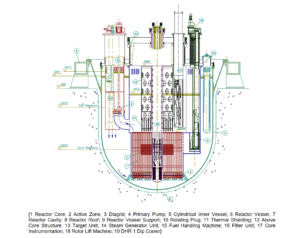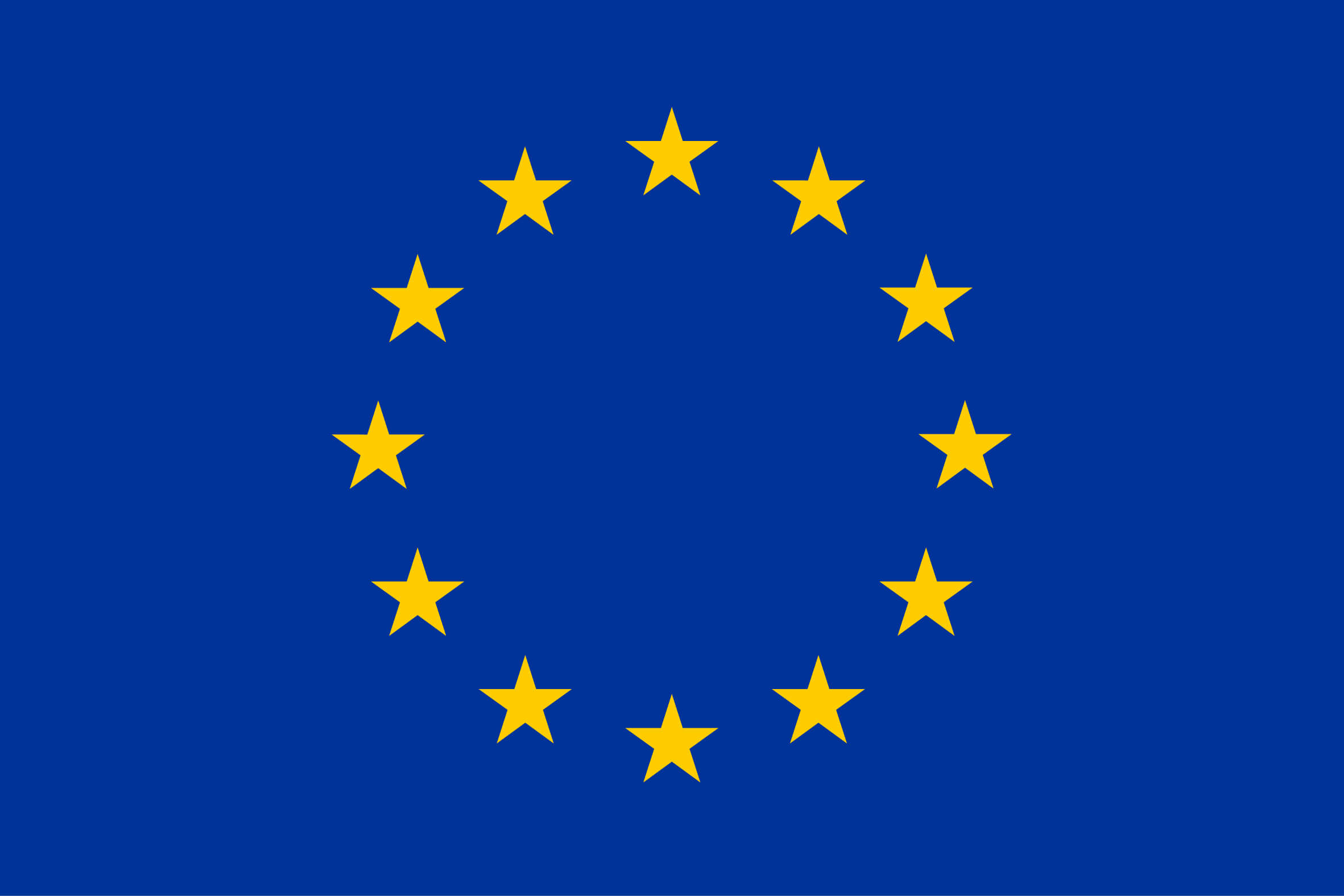EUROTRANS: EUROpean research Programme for the TRANSmutation of high level nuclear waste in an accelerator driven system
EUROTRANS (EUROpean research Programme for the TRANSmutation of high level nuclear waste in an accelerator driven system) was a programme to design an Accelerator Driven System (ADS) for the transmutation of components of nuclear waste and develop related technology and knowledge.
Overview
Project Dates: 01/04/2005 – 31/03/2010
Project Status: Closed
Website: www.fzk.de/eurotrans (now taken down)
Minor actinides, particularly americium, curium and californium, contribute significantly to the long-term radiotoxic inventory of most spent nuclear fuels. The quantity of material that must be committed to a geological disposal facility might be substantially reduced or consolidated by partitioning the minor actinides and subsequently transmuting them into short-lived or stable nuclides (the Partition and Transmute or P&T strategy).
The EUROTRANS project was focused on the design and development of a transmutation system for a potential future P&T process. Its sister project, EUROPART, focused on partitioning technologies.
The technological focus of the EUROTRANS project was on transmutation and/or burning (fissioning) in an Accelerator Driven System (ADS). An ADS is a type of sub-critical reactor that relies on neutrons produced by an accelerator to sustain fission. The EUROTRANS project developed a detailed design for a research-scale ADS and a larger industrial-scale ADS demonstrator. It also overcame a variety of engineering and technical challenges associated with creating an ADS and developed the supporting knowledge significantly.
Objective
The objective of the EUROTRANS Integrated Project was to carry out a preliminary detailed design of the eXperimental Transmuter based on the ADS concept (XT-ADS), a ~100 MW experimental facility demonstrating the technical feasibility of transmutation in an ADS. The objective was also to accomplish a reference conceptual design (several 100 MW) of a modular generic European Transmutation Demonstrator (ETD) in the long term.
The EUROTRANS project was divided into a number of technical domains with activities supporting the overall aims of the project. The technical domains and domain objectives were:
- DM1 DESIGN: Develop a detailed design of a proton accelerator-driven, windowless 100MW sub-critical XT-ADS (Pb-Bi for coolant and spallation target, MOX fuel), together with a conceptual design of a Generic ETD (Pb for coolant and spallation target, minor actinide (MA) oxide fuel). Carry out an economic assessment and safety study of the two designs.
- DM2 ECATS (Experimental activities on the Coupling of an Accelerator, a spallation Target and a Sub-critical blanket): Provide validated experimental input from relevant experiments at sufficient power (20-100 kW) on the coupling of an accelerator, a spallation target and a sub-critical blanket.
- DM3 AFTRA (Advanced Fuels for TRAnsmutation systems): Develop U-free oxide fuels such as (Pu, MA, Zr)O2, 92Mo CERamic-METal fuel (CERMAT) and MgO CERamic-CERamic fuel (CERCER), with a view to their use both in XT-ADS and Generic ETD, requiring design and modelling, safety assessment, out-of-pile fuel-property measurements, irradiation tests and fuel qualification in HFR and Phénix reactors.
- DM4 DEMETRA (DEvelopment and assessment of structural materials and heavy liquid Metal technologies for TRAnsmutation systems): Develop and assess structural materials, thermal-hydraulics, and heavy-liquid metal technologies for transmutation systems in respect to spallation target material and to coolant.
- DM5 NUDATRA (NUclear DAta for TRAnsmutation): Improve nuclear data evaluated files and models needed to perform the design work.
Results
The EUROTRANS project met its main goals in delivering a detailed design for the XT-ADS as well as a European transmutation demonstrator, in the form of the lead-cooled European Facility for Industrial-scale Transmutation (EFIT-Pb). Additionally, the experimental programme undertook a variety of activities to support the development of ADS technology. The main achievements of each of the EUROTRANS technical domains were:
- DM1 DESIGN: The project designed both the XT-ADS and EFIT-Pb systems to a detailed level.
- The design of the XT-ADS was initially based on the SCK/CEN MYRRHA design file. The XT-ADS is designed as a fast neutron irradiation facility with the additional function of demonstrating important design elements of the EFIT ADS. The coolant of the XT-ADS design is Lead-Bismuth Eutectic (LBE), which also serves as the neutron spallation target for the accelerator. The windowless design overcomes a number of challenges relating to the design of a sufficiently robust the source window. The design power of the core is 57 MWth with an operating k-effective of 0.938.
- The EFIT-Pb design, shown in Figure 1, is a 385 MWth reactor designed to achieve a minor actinide destruction rate of 42 kg/TWh (thermal), or about 390 g/day at full power. The EFIT-Pb design has a number of passive safety features which ensure any potential accidents are both low-probability and low-consequence. A helium gas-cooled variant was also designed, the EFIT-He. The EFIT-He design avoided some of the corrosion challenges associated with liquid lead cooling but was noted to have inferior passive safety compared to the EFIT-Pb in its current iteration.
- DM2 ECATS: Through the ECATS domain sub-project, EUROTRANS supported a variety of relevant experiments on the coupling of an accelerator, a target and a sub-critical blanket. The relevant experiments concerned were:
- The YALINA experiments in Belarus. These experiments are of the MUSE type, i.e. a neutron generator is coupled to a flexible zero-power sub-critical assembly.
- The RACE (Reactor Accelerator Coupled Experiment) experiments at Low Power (LP) operated in two different facilities: the TRIGA reactor of the ENEA/CASACIA named “RACE-T” and the RACE sub-critical assembly of the Idaho Accelerator Center (IAC) named “RACE-LP/IAC” in the USA.
- The GUINEVERE (Generator of Uninterrupted Intense NEutrons at the lead VEnus REactor) program, proposed by SCK-CEN. In this program it was proposed to modify the critical facility VENUS located at Mol and to couple it with a dedicated GENEPI accelerator to perform the GUINEVERE experiment.
- DM3 AFTRA: Several design options for both CERCER and CERMET fuel cores were investigated. A fuel safety assessment was undertaken for each one and their suitability was investigated against a number of factors. An irradiation programme was undertaken to investigate the behaviour of both fuels under ADS conditions and out-of-pile measurements were used to determine thermal, mechanical and physico-chemical properties.
- DM4 DEMETRA: A materials characterisation programme in support of the ADS design programme was undertaken, which included long-term corrosion tests, mechanical tests in heavy liquid metal and irradiation experiments. A corrosion protection method based on the GESA surface-alloying technique was developed and characterised. Additionally the thermal-hydraulics of the liquid metal neutron spallation target were explored through a series of experiments and models.
- DM5 NUDATRA: The project supported a number of experiments and efforts to improve nuclear code and data libraries (particularly relating to lead and bismuth isotopes). Experiments were performed to improve the assessment for radioactivity, chemical modification and damage under irradiation, and to evaluate a number of relevant neutron scattering, capture, and induced fission reactions. Improvements were implemented in the TALYS code and contributed to the libraries included in the Jeff-3.2 release.



